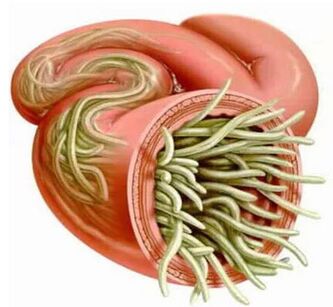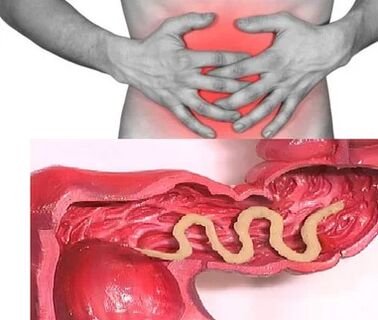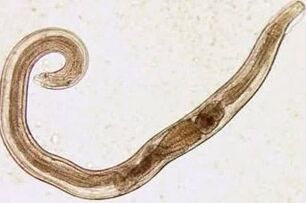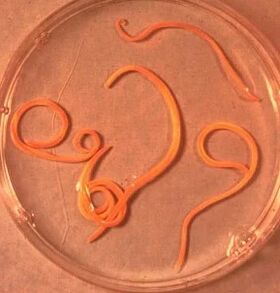So far, science is known on 280 types of worms that can develop and live in the human body, parasitizing in various organs and tissues.The frequency of human infection depends on the climatic and socioeconomic conditions of specific territories (in underdeveloped countries, especially those located in the tropical and subtropical zone, the level of parasitic infections is much higher than in economically developed states).
Human infection methods with helminths:
- Biogelmintois (animal infection).
- Helminto contagionine (transmitted from person to person).
- Geogelminths (diseases caused by parasites that conduct one of the vital cycles of the earth).

Factors that affect the manifestations of helminties
The parasite penetration method in the body:
- The degree of adaptation of helminth to the human body;
- The density of the population (quantity) of parasitic individuals;
- Worm habitat (fabric parasites live in the thickness of soft tissues and the clearing live in the gaps of the hollow organs).Some helminths in various phases have educational and fabric forms.Larval and worm -developing stages, as a rule, cause more pronounced pathological changes.
In the absence of re -infection, the number of adult parasites in the human body does not increase.This feature significantly distinguishes helmintic invasions from diseases caused by bacteria, viruses, fungi and simple organisms.
Worms in Humans: Symptoms
Helminthose is a disease that is characterized by 2 stages of the course (acute, two weeks to two months) and chronic (several months to several years).
Acute phase symptoms of helminthiasis
The first signs of the disease can manifest in different times (most of the time after 2-3 weeks, with ascaridosis-after 2-3 days and with philariosis, the incubation period can last 6 to 18 months).
At the acute stage of parasitic invasion, the most characteristic symptom is an allergic reaction (antibodies are generated for parasitic migratory larvae antigens).Often, itching eruptions, prone to the recurring course, have an increase in the recurring course, regional lymph nodes appear on the skin and the occurrence of generalized or local edema, muscle and joint pain may occur.In addition, parasite migration larvae can cause chest pain, coughing, asphyxiation asphyxiation, stool disorders, nausea and vomiting.
At the same time, the acute phase of helminthiasis can be accompanied by more severe disorders (severe forms of pneumonia, hepatitis, allergic myocarditis, hepatosterogaly (an increase in liver and spleen).
In the blood, the amount of eosinophils (eosinophilia) increases and the normal quantitative reason between protein fractions (dysproteinemia) is disturbed.

Signs of chronic helminthiasis
The symptoms of the chronic phase depend directly on which organ is "populated" with parasites, as well as their size and quantity play an important role.
Thus, when parasitic in the gut of single individuals, the disease can occur asymptomatic (except cases of very large parasites infection).The characteristics characteristics of the chronic phase of intestinal helminthiasis are dyspeptic disorders.In children, acenoarotic syndrome and pain is more pronounced.With massive ascarides, intestinal obstruction, mechanical jaundice and pancreatitis is possible.
By consuming all the substances needed for their vital activity of the host body, helminths cause digestive disorders, violations of vitamins, minerals, carbohydrates, proteins and fats.At the same time, worms life products inhibit normal intestinal microflora and reduce the body's immunological forces.
In people suffering from helminties, due to weakened immunity and the enhanced process of cell division (consequences of constant restoration of tissue parasites), the risk of malignant tumors increases significantly.
Types of parasitic helminths in the human body
The causative agents of human helminthiasis are 2 types of worms: round (nematodes) and flat (tape and records).
Round worms
Pinworm
The parasites that are the cause of enterobiosis are small fine cavity worms (up to 10 mm) that have grayish white coloration.The infection occurs in a food (through the mouth).The reason for this is the dirty hands.Parasite eggs may be on the soil, in the wool of infected animals, vegetables and non -washed fruits, etc.At the same time, with enterobiosis, cases of self -extension (especially in children) that occur as a result of combing areas and subsequent egg notches are not uncommon.The cutting larva develops within two weeks in the digestive tract.Becoming an adult individual, the worm parasitizes in the lower parts of the small and upper parts of the colon.

Askare
Askaride is a large parasite of a shaped shaped of yellow-colored axle, reaching an adult state of 40 cm (females) and 15-25 cm (men).Without a glass of suction or other fixing devices, ascaride may move independently toward food masses.The eggs deposited by the female parasite are distinguished with feces.
Academy infection occurs in case of swallowing mature eggs, along with uninsy water or vegetables and fruits in which there are particles of the soil.After the eggs penetrate the intestines, the mature larvae leave them.Then, introducing into the intestinal wall, they reach the heart according to blood flow and, from there, fall into the lungs.Through the pulmonary alveoli, the ascarious larva through the respiratory tract penetrates the oral cavity again.After repeated swallowing, the parasite reaches the small intestine, where it develops in an adult.The worm lives for 12 months, then dies and stands out with feces.In the gut of a owner, it can live one or several hundred individuals.
Vlashev
Vlasov, the causative agent of tricocefalosis, is a white helminth that parasitizes in the early part of the large intestine and reaches a size of 4-5 cm.The parasite is powered by the blood and tissues of the rectal mucosa.
The eggs glued by hiccups placed by the female on the intestine walls come along with the feces.Its development occurs in the environment (ideally in the soil).The eggs with parasites larvae are penetrated in the body with a diet, through dirty hands, with water or uninsy vegetables and fruits.

Trichinella
The causative agent of tricelelosis is a small round helminth that reaches 2-5 mm in length.The infection occurs when the use of fried bad meat (pork, bear puppies, boar).Penetrating the gut, the larva of the parasite in 3-4 days matures the state of the sexually mature individual.The life expectancy of the worm is 40 days after which the parasite dies.Driving the intestinal wall, the larvae penetrates the bloodstream and are transported in all organs of the human body, settling in the muscles.In this case, the breathing and facial muscles, as well as the muscles of the limbs folds, are more often affected.
In the early days after the invasion, patients complain of abdominal pain.Then, after about 2 weeks, body temperature rises to 39-40 s, rashes appear on the skin, muscle pain develops and the waves of the face.During this period, in the case of massive infection, there is a significant risk of death.After about a month, recovery occurs.The parasite is encapsulated in a spiral form, after which he dies within two years.
Ankylostoma and non -core
These two parasites are similar to each other by biological characteristics as well as in diseases caused.With this, it is customary to them under the general name (ankylosstoma).The worms that reach lengths 10-15 mm are parasitized on 12-p.intestine.It should be noted that this is one of the most common, but at the same time rarely identified parasites.Worm worms penetrate the human body through the skin when in contact with the infected soil.In addition, entering the bloodstream, they, as well as Ascarides, migrate to the lungs and then, through the bronchial, along with the leap sputter - to the digestive tract.Anchylostoma parasitizes in the intestine, connecting to the intestinal wall.A parasite that eats exclusively with blood bites the blood vessels drilling the mucous membrane, injecting an anti -impossible component there.During the day, an adult can absorb 0.05-0.35 ml of blood on average.Therefore, the most characteristic symptom of this helminthiasis is iron deficiency anemia as well as a change in the proportion of protein fractions (dysproteinemia).
Plans
Wide tape
This is one of the largest helminths that reach a length of 10 to 20 meters.The disease caused by this parasite is called Dipillobotriosis.The worm development cycle begins with freshwater or crustacean fish.The larva enters the human body, which is the final owner of a wide ribbon with caviar or infected fish fillet.Arriving at the small intestine, the parasite is attached to its wall and, for 20 to 25 days, grows to a sexually mature individual.
Hepatic bacon
A parasite that causes opistchiasis is a flat worm that reaches a length of 7-20 mm.It should be noted that more than 50% of cases of infection with a liver disk (also called cat biconomater) falls on the inhabitants of Russia.Parasitic larvae begin to develop after eggs fall into fresh water (from swallowed snails).So they penetrate the body of the fish (carp, cruciana carp, grain, cheap).Human infection occurs when you eat infected fish meat that has not undergone sufficient heat treatment.The larva of the thin intestine hepatic pump penetrates the bile ducts and gallbladder, fixing it with two suction glasses.
Taurus and pork
These almost identical parasites in structure reach a length of 5-6 meters.Tusianic infection and tusiasis occurs due to the use of cattle or pork infected with Finns (one of the intermediate forms of helminthiasis).Visible Finns, presented in the form of whitish blisters, reaching 0.5 cm in size, are attached to a person's small intestine wall and in 3 months turn into an adult individual.The parasite of the track, consisting of over 2000 segments, is growing constantly.At the same time, the final segments that contain eggs come out and move independently along the colon to the anal opening and then crawl out of the anal or stand out in the outside environment along with the feces.The most characteristic symptoms of helminthiasis are a violation of the digestive tract.
Echinococcus
For this parasite, a person is an intermediate host.The worm parasitizes in the human body in the form of Finns.Echinococcus's final owner is a wolf, a dog or a cat.Infection occurs in a feeding manner in contact with animals and environmental objects, with the handful of echinococcus eggs.After entering the gut, the oncosferas (larvae of six black) develop from them.From the intestine, they penetrate the bloodstream and are transported throughout the body.
Alveokokk
This parasite, which is considered a variety of echinococcus, is the cause of one of the most dangerous helmintites (alveococosis), which is similar in gravity with cirrhosis and liver cancer.Infection occurs with oncosphere penetration (eggs with mature larvae) in the intestine.There, the embryo comes out of the egg and, introducing into the intestinal walls, penetrates the bloodstream.In addition, with a blood flow, the parasite spreads through all body tissues and organs (more often located in the liver).This is where the main stage of development begins at the larvae (a multi -cacial bubble, laurelocisty) is formed).Each camera contains a parasite embryo head that continues to develop gradually.Lavrocists are very aggressive formations that grow constantly due to increased bubbles, as well as the ability to germinate in the liver, such as cancer metastases.
Helminthiasis diagnosis
The diagnosis of helm tentn invasions includes the following events:
- A complete collection of an anamnesis that helps discover the possible causes of infection;
- Laboratory studies of feces, blood, 12p intestines content, rectal and perianal mucus, muscle tissue, pulmonary sputum, bile.During the analysis, eggs, segments or parasitic fragments can be detected.At the same time, increased content of eosinophils in the blood is also a sign about the presence of helminthiasis.
- In the diagnosis of diseases caused by larval stages or tissue parasites, serological studies are performed (Elisu, RSC, indirect agglutination, immunofluorescence analysis, etc.).
- Identify helminths that affect liver tissue, ultrasound, CT and endoscopic studies are prescribed.
Worms in Humans: Treatment
In the acute phase of a parasitic infection, the patient receives detoxification and desensitization of therapy.In a severe course of the disease (hepatic trematodosis, tricelelosis), glucocorticoids are used according to medical indications.
As specific medicines, taking into account the nature of the pathogen, special anti -helmintic chemotherapeutic agents are prescribed.
At the same time, the patient is recommended to take anti -histamines and enjoinors.The final stage of treatment includes the use of probiotics that normalize intestinal microflora.
A special sparing diet is also prescribed (foods should be easily digestible and contain little fat).
During the anti -helmintic therapy, the patient needs strict adherence to personal hygiene (in order to avoid re -infection).At the same time, with many helminthiasis, all family members and people infected in constant contact should be undergoing treatment.





















